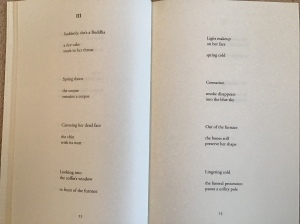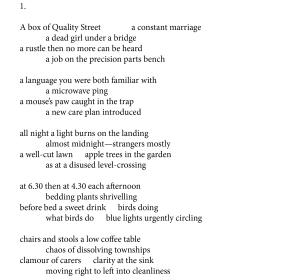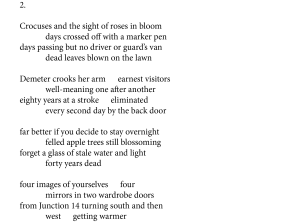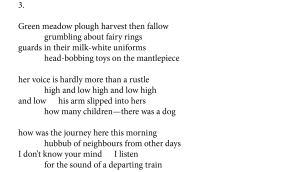Bloodaxe poet, editor and tutor, Chrissy Williams, set up and edits PERVERSE poetry. Her site’s strap-line for publication is that she’s looking for “deliberate, obstinate, unreasonable or unacceptable poems, contrary to the accepted or expected standard or practice”. A willful outlier, in other words, looking for experiments and/or orphans. Some of you – if you subscribe to her site or keep an eye on social media – may have seen three pieces I’ve written which PERVERSE published last week. These were the opening three poems from a sequence of twelve and the Note published with them by PERVERSE explains a good deal (I’ll put the poems themselves at the end of this post).
Note: these poems are from a sequence in the form of an abecedary, a calendar of 12 pieces. Carolyn Forche’s ‘On Earth’ first interested me in this form. She associates its inclusiveness (from A-Z) with the pleroma, the fullness of God’s creation, the One. The fullness I have aimed at in this case was the difficult last years of my parents’ lives. Drawing on notes I made between 2016 – 2018, the disjointed nature of this particular totality reflects their growing illness and confusion; but I hope the whole exudes what it was written with, love.
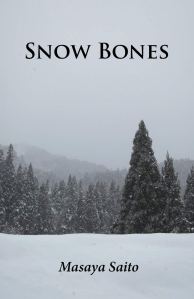 On the theme of ‘how poems come to be written’, today I’m posting images of a couple of the pages from my notebook of the time. You’ll see phrases and images which made it through to the final poems. As can perhaps be seen from the scribbles, what I had originally in mind was something close to the form of haiku. I’d been reading and admiring Masaya Saito’s book of haiku called Snow Bones. This had just been published in 2016 by Paul Rossiter’s Isobar Press (I think maybe I’d bought the book at the Poetry Book Fair that year). Snow Bones consist of four narrative haiku sequences, spoken by several different voices. Saito writes in both English and Japanese (these poems are all in English). Two of these sequences focus on the death and funerals of parents and what I admired was the way in which the compression of the form allowed the poet to express the powerful emotions of love and grief. Between 2016-18, my mother and father were going through a decline in both mental and physical health, eventually moving into a care home, sadly both dying within 18 months of each other. So I had my own powerful feelings to deal with and one of the ways of coping was to try to write about these experiences.
On the theme of ‘how poems come to be written’, today I’m posting images of a couple of the pages from my notebook of the time. You’ll see phrases and images which made it through to the final poems. As can perhaps be seen from the scribbles, what I had originally in mind was something close to the form of haiku. I’d been reading and admiring Masaya Saito’s book of haiku called Snow Bones. This had just been published in 2016 by Paul Rossiter’s Isobar Press (I think maybe I’d bought the book at the Poetry Book Fair that year). Snow Bones consist of four narrative haiku sequences, spoken by several different voices. Saito writes in both English and Japanese (these poems are all in English). Two of these sequences focus on the death and funerals of parents and what I admired was the way in which the compression of the form allowed the poet to express the powerful emotions of love and grief. Between 2016-18, my mother and father were going through a decline in both mental and physical health, eventually moving into a care home, sadly both dying within 18 months of each other. So I had my own powerful feelings to deal with and one of the ways of coping was to try to write about these experiences.
Here’s a couple of pages from Saito’s book. You’ll see he does not approach the haiku form in the rather rigid syllabic way that we often think of it. Also I liked the way in which – of the 3 lines – he always sets one off, either opening or closing. This creates drama and tension even within such a short space.
So then here’s a page from my notebook of the time – the crossings out indicate that I have used the text going forward. Initially I tried to maintain my hopes of a haiku sequence. I can see here phrases that made it into the final poem (in such a different form): the box of Quality Street chocolates, the days passing as at a level crossing, the introduction of a new care plan while they were still living at home. I remember taking a dozen or so of these haiku pieces to a writing workshop. The response was polite, even some enthusiasm, but I felt this was in part a response to the personal nature of the subject matter as much as to the success of the choices I’d made as a poet. (These are always very difficult moments in a workshop – depth of involvement on the writer’s part often makes more cool, critical observations hard to bring forward).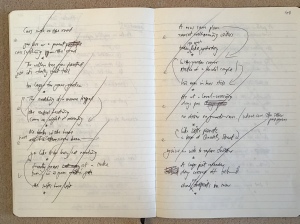 So I wasn’t sure. The texts stayed in another notebook. This is what happens (for me at least). I’d then often be browsing back through the notebook at those bits of text not yet crossed through as having been advanced to the next stage. I’m re-reading to see if there remains any life in these fragments left in limbo. I kept reading these haiku and thinking there was a lot of good writing, but they had certainly not found their right form.
So I wasn’t sure. The texts stayed in another notebook. This is what happens (for me at least). I’d then often be browsing back through the notebook at those bits of text not yet crossed through as having been advanced to the next stage. I’m re-reading to see if there remains any life in these fragments left in limbo. I kept reading these haiku and thinking there was a lot of good writing, but they had certainly not found their right form.
Here’s another image of an original page.
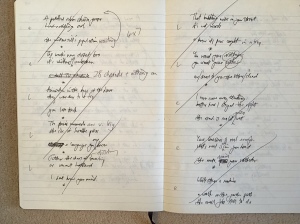 The fourth haiku here I still like:
The fourth haiku here I still like:
The phone’s numerals are very big
the size of Scrabble pieces
a language you once knew
In the final poems, the image of a “language” re-emerges rather changed. The sixth haiku poem here has an image of “a shrew its paw caught in a trap” which is itself an echo of a line from the previous page (“The scratching of a mouse trapped”) – the relevance of these recurring images of entrapment is obvious given my parents were pretty well confined to their house by physical weakness and mental uncertainties. Such images surface in the final poems, in the first poem’s opening quatrain, as “a mouse’s paw caught in the trap”.
I don’t remember when the final choice about these poems was made – the one that decided an abecedary form would be appropriate. Those who have followed this blog for a few years will have heard me ruminating on this form before and on my discovery of it via Carolyn Forche. In rational terms, I felt the systematic coherence imposed on phrases by the alphabetical sequence would be effective in an ironic way because most of the fragmented material I had assembled spoke to an incoherence rooted in the way my parents were now living. Is it too much to say that I was hoping to piece things together for Mum and Dad in a way that they were unable to themselves? There are other (more conventional) poems about my parents in my most recent full collection, The Lovely Disciplines.
The re-shaping of the text worked (to my mind). Assembling something like this is a thrilling balance of chance (the sequence of the alphabet) and choice (the poet retains the right to trim and edit phrases). The title I’ve given the sequence comes from the last haiku in the first image above:
A large print calendar
days crossed off behind
ahead no footprints in the snow
I remember buying them a large print calendar so they could follow the days passing more easily. Often – but not always – they’d cross through the days passed. When we cleared the house eventually, the calendar was still hanging up, the crossed off days having stopped at a certain point; the future days left blank and pristine. The walls of the house have not been literally demolished. But it has been sold on to another family and so for me and my brothers the walls might as well have been demolished. The lives lived out there are gone, except for what we can remember (some of which can be written down).
Here are the three poems in the sequence (from A to I) that have so far been published:
from Notes on a calendar (hung on a demolished wall)
